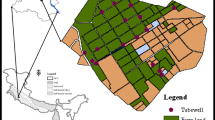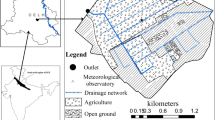Abstract
Sustainability of irrigated agriculture in the semi-arid regions such as the rice growing regions of the southern Australia could be under serious threat due to recharge to saline groundwater leading to secondary salinisation. This paper presents two approaches to reduce net recharge to shallow saline groundwater from ponded rice cropping systems using a soil, water and groundwater management model–SWAGMAN model. First approach applies the concept of growing deep-rooted crop (crop consuming water from soil and shallow water table) over an area equivalent to recharge from a unit area of rice crop to maintain the total water balance. The second approach involves achieving whole farm water balance for average and wet climatic conditions to find out optimum cropping pattern to minimise recharge from rice based system. Results of both approaches are sensitive to water table depth and regional groundwater outflow rates. The first approach was applied to determine an optimal mix of rice/lucerne crop to keep water tables and average soil salinity changes less than 0 m/year and 0.015 dS/m, respectively. The area of lucerne required to match the net groundwater rise caused by 1 ha of rice is 1.27, 2.45 and 3.55 ha for 1, 0.5 and 0.2 ML/ha regional groundwater outflow capacity. Results from second approach revealed that it is possible to control net recharge under above average rainfall using a suitable whole farm cropping mix e.g. 50 ha rice–wheat rotation, 19 ha rice, 25 ha of lucerne and 136 ha of fallow.









Similar content being viewed by others
References
Beecher HG (2005) Better prediction of groundwater recharge from rice growing, Research Report No. P1102FR09-05 Cooperative Research Centre for Sustainable Rice Production. Yanco Agricultural Institute, Yanco, ISBN 1876903440
Beecher HG, Hume IH, Dunn BW (2002) Improved method for assessing rice soil suitability to restrict recharge. Aust J Exp Agric 42:297–307
Gibbs WJ, Maher JV (1967), Rainfall deciles as drought indicators. Commonwealth of Australia, Bureau of Meteorology, Melbourne, Bulletin No. 48
Humphreys E, Van der Lelij A, Muirhead WA, Hoey D (1994) The development of environmental restrictions for rice growing in New South Wales. Aust J Soil Water Conserv 7(2):11–20
Humphreys E, Lewin LG, Khan S, Beecher HG, Lacy JM, Thompson JA, Batten GD, Brown A, Russell CA, Christen EW, Dunn BW (2006) Integration of approaches to increasing water use efficiency in rice-based systems in southeast Australia. Field Crops Res 97:19–33
Khan S (2005) Rethinking Rational Solutions for Irrigation Salinity. Aust J Water Resour Special Issue on Salinity Eng 9(2):129–140
Khan S, Xevi E, Meyer WS (2003) Salt, water and groundwater management models to determine sustainable cropping patterns in shallow saline groundwater regions—special volume of the journal of crop production titled crop production in saline environments. Co-published simultaneously In: Goyal SS, Sharma SK, Williams D (eds) Crop production in saline environments, global and integrative perspectives, Haworth Press, pp 325–340
Khan S, Rana T, Yuanli C, Blackwell J (2006) Can irrigation be sustainable? Agric Water Manage 80:87–99
Khan S, O’Connell N, Rana T, Xevi E (2007) Hydrologic-economic model for managing irrigation intensity in irrigation areas for water table and soil salinity targets. Environ Model Assess. doi: 10.1007/s10666-006-9081-3. http://www.dx.doi.org/10.1007/s10666-006-9081-3
Leslie D (1992) Rice 2000: environmental policy paper, Dwyer Leslie Pty Ltd, Canberra
Van der Lelij A, Talsma T (1978) Infiltration and water movement in Riverina plain soils used for ricegrowing. In: Storrier RR, Kelly ID (eds) Hydrogeology of the Riverina Plain of south-east. Australian Society of Soil Science Inc., Riverina Branch, pp 89–98
Acknowledgments
Project funding from the Coleambally Irrigation Cooperative Limited is acknowledged. Inputs from the Coleambally Irrigation Cooperative Limited Environmental Committee provided useful sensibility checks for this work.
Author information
Authors and Affiliations
Corresponding author
Rights and permissions
About this article
Cite this article
Khan, S. Equivalent cropping area and whole farm water balance approaches to reduce net recharge to shallow saline groundwater from rice based cropping systems. Paddy Water Environ 5, 143–152 (2007). https://doi.org/10.1007/s10333-007-0078-6
Received:
Accepted:
Published:
Issue Date:
DOI: https://doi.org/10.1007/s10333-007-0078-6




